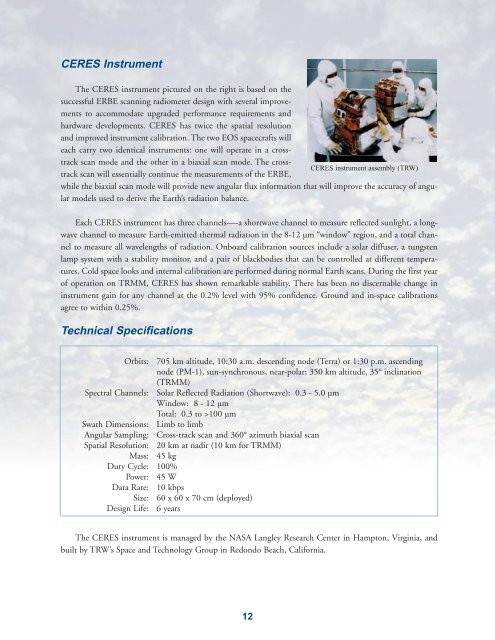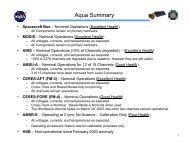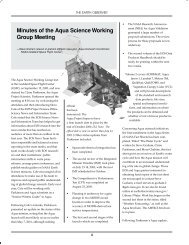CERES - Aqua - NASA
CERES - Aqua - NASA
CERES - Aqua - NASA
You also want an ePaper? Increase the reach of your titles
YUMPU automatically turns print PDFs into web optimized ePapers that Google loves.
<strong>CERES</strong> InstrumentThe <strong>CERES</strong> instrument pictured on the right is based on thesuccessful ERBE scanning radiometer design with several improvementsto accommodate upgraded performance requirements andhardware developments. <strong>CERES</strong> has twice the spatial resolutionand improved instrument calibration. The two EOS spacecrafts willeach carry two identical instruments: one will operate in a crosstrackscan mode and the other in a biaxial scan mode. The crosstrackscan will essentially continue the measurements of the ERBE,<strong>CERES</strong> instrument assembly (TRW)while the biaxial scan mode will provide new angular flux information that will improve the accuracy of angularmodels used to derive the Earth’s radiation balance.Each <strong>CERES</strong> instrument has three channels—-a shortwave channel to measure reflected sunlight, a longwavechannel to measure Earth-emitted thermal radiation in the 8-12 µm “window” region, and a total channelto measure all wavelengths of radiation. Onboard calibration sources include a solar diffuser, a tungstenlamp system with a stability monitor, and a pair of blackbodies that can be controlled at different temperatures.Cold space looks and internal calibration are performed during normal Earth scans. During the first yearof operation on TRMM, <strong>CERES</strong> has shown remarkable stability. There has been no discernable change ininstrument gain for any channel at the 0.2% level with 95% confidence. Ground and in-space calibrationsagree to within 0.25%.Technical SpecificationsOrbits: 705 km altitude, 10:30 a.m. descending node (Terra) or 1:30 p.m. ascendingnode (PM-1), sun-synchronous, near-polar; 350 km altitude, 35° inclination(TRMM)Spectral Channels: Solar Reflected Radiation (Shortwave): 0.3 - 5.0 µmWindow: 8 - 12 µmTotal: 0.3 to >100 µmSwath Dimensions: Limb to limbAngular Sampling: Cross-track scan and 360° azimuth biaxial scanSpatial Resolution: 20 km at nadir (10 km for TRMM)Mass: 45 kgDuty Cycle: 100%Power: 45 WData Rate: 10 kbpsSize: 60 x 60 x 70 cm (deployed)Design Life: 6 yearsThe <strong>CERES</strong> instrument is managed by the <strong>NASA</strong> Langley Research Center in Hampton, Virginia, andbuilt by TRW’s Space and Technology Group in Redondo Beach, California.12





